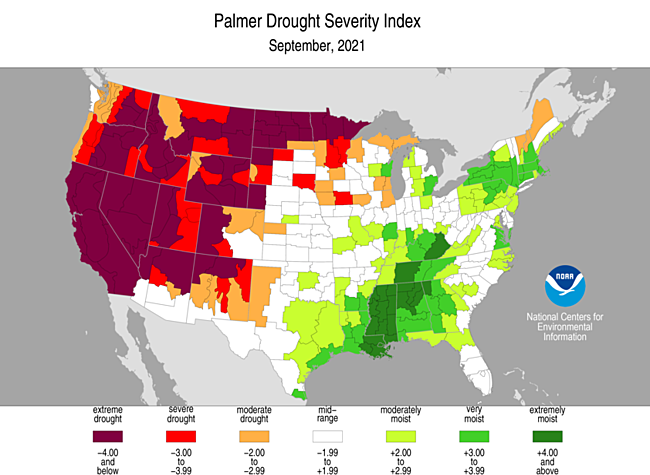Drought
Drought is a very familiar foe in parts of the US, significant regions of Africa, and much of Australia. Drought is often called a creeping disaster, as it decimates a region slowly. We will talk a lot more about drought in Modules 8 and 9. Here, we briefly consider the recent record of drought. As we saw previously with research on drought and the Mayans, oxygen isotopes of stalactites can be interpreted in terms of precipitation. Another indicator of drought is the width of tree rings. One of the most comprehensive tree-ring data sets is shown in a compilation of precipitation in New Mexico from 137 BC to 1992 (The New York Times, The Longest Measure of Drought: 21 Centuries of Rainfall in New Mexico). The data set shows that with the exception of a wet phase in the last decade, much of the 20th century was dry in New Mexico, and, in general, the data suggest that western North America has become drier over the last 1000 years.
As it turns out, there is solid evidence that the severity of droughts has increased over the long term in many parts of the world. And, as it turns out, climate models predict that drought will become a part of everyday life in many regions in the coming century. In the US, these areas include large parts of the west and south central (Kansas, Oklahoma, Texas). Especially in California, climate models suggest that warmer years in the future are more likely to also be drier years, and this will increase the severity of future droughts.
So, how is the severity of drought quantified? The most widely used method to measure drought today and in the past is the Palmer Drought Severity Index (PDSI). This index is an accounting of the balance of supply of moisture via precipitation and demand for moisture via potential evapotranspiration (PE). The PE is the amount of water that could be evaporated given an unlimited supply of water. The National Oceanic and Atmospheric Association (NOAA) publishes a map of the PDSI over the US every month (see figure below).

This image is a map of the United States titled "Palmer Drought Severity Index, September 2021," produced by the National Centers for Environmental Information (NOAA). The map uses a color gradient to show drought severity across the U.S. during this period.
- Map Type: U.S. map
- Measurement: Palmer Drought Severity Index (PDSI)
- Date: September 2021
- Color Scale (bottom of the map):
- Range: -4.00 (extreme drought) to 4.00 (extremely moist)
- Colors: Dark red (extreme drought, -4.00) to dark green (extremely moist, 4.00)
- Categories: Extreme drought, severe drought, moderate drought, mid-range, moderately moist, very moist, extremely moist
- Regions with Notable Conditions:
- Extreme Drought (dark red, -4.00):
- Western U.S. (California, Nevada, Utah, Montana, Idaho)
- Parts of the Upper Midwest (Minnesota, North Dakota)
- Severe Drought (red, -3.00 to -3.99):
- Much of the Western U.S. (Oregon, Washington, Wyoming, Colorado)
- Parts of the Great Plains (Nebraska, South Dakota)
- Moderate Drought (orange, -2.00 to -2.99):
- Southwest (Arizona, New Mexico)
- Parts of the Midwest (Iowa, Wisconsin)
- Mid-Range (white, -1.99 to 1.99):
- Central U.S. (Kansas, Oklahoma, Missouri)
- Parts of the Northeast (New York, Pennsylvania)
- Moderately Moist (light green, 2.00 to 2.99):
- Southeast (Georgia, Alabama, Mississippi)
- Parts of the Midwest (Illinois, Indiana)
- Very Moist (green, 3.00 to 3.99):
- Parts of the Southeast (Louisiana, Arkansas)
- Parts of the Northeast (Maine, Vermont)
- Extremely Moist (dark green, 4.00):
- Small areas in the Southeast (parts of Louisiana)
- Extreme Drought (dark red, -4.00):
The map shows severe to extreme drought conditions dominating the Western U.S. and Upper Midwest, while the Southeast and parts of the Northeast experienced moist to extremely moist conditions in September 2021.
The PDSI has increased (become drier) for the driest parts of the globe since 1950. For most of the US, the PDSI has decreased for this time period. However, the last century has seen severe droughts in certain regions. For example, the major drought of the 1930s Dust Bowl in the Central US caused severe hardship for farmers and others in this region. The 1950s and 1980s also saw severe droughts in the Great Plains of the US. We will find out in Module 4 how models project that the severity of droughts will increase in many parts of the globe with future climate change. Moreover, we will learn more about the impact of drought on water supply in Module 8 and on food in Module 9.
Drought is currently at a critical level out west. Lake Powell, which is the second largest reservoir in the western US is currently at its lowest level in history and approaching the level where water and hydroelectric power supplies are threatened. This event would be especially devastating for communities that rely on the lake for water, such as Las Vegas, Nevada. We will come back to this issue in Module 8.
The latest (2022) report of the Intergovernmental Panel on Climate Change (IPCC), the large international team of scientists tasked with predicting our climate future and its impact, issues stern warnings about drought in the western US, Australia, the Mediterranean region and sub-Saharan Africa. Drought will have a major impact on human health, largely because of its effect on accessibility to clean drinking water, and require major adaptation of communities. Adaptation can involve conservation measures as well as finding new sources of water, for example desalinization. Such adaptation will be easier in developed countries like the US compared to the developing world, where countries like Yemen and Madagascar are already struggling with the devastating impact of drought and do not have the resources required to adapt.

